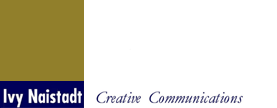Speed Kills!
One of the most common mistakes people make when communicating in public, particularly if they are nervous, is speaking too fast.
In a recent Advanced ‘Join The Ivy League’ Coaching Program, there was a reserved elegant gentleman who was having a tough time. To my surprise, every time he got up to speak, he spoke too quickly. Although he was very skilled at tailoring a concise message for his audience, his speedy delivery undermined all his good preparation. The clarity of his message was lost.
Unfortunately, what happens when you speak too quickly is you diminish your credibility. You look and sound like you want to get through it and get out of there as quickly as possible, which is not the best way to win over your audience. Conversely, if you speak too slowly or pause too much, you risk coming across as stilted or even patronizing.
There are a couple of possibilities as to what’s driving your speed. Perhaps you’re nervous because you have a fear of being judged negatively and let’s face it, in many business presentations you are being judged!
Or you may be an Adrenalizor (one of four profiles in chapter 2, “What’s Your Nervousness Profile?” from Speak Without Fear). The Adrenalizor is like an athlete gearing up for a race who feels a rush of adrenaline close to the event, and the symptoms can be difficult to manage. Or, maybe you just speak quickly.
In any case, here are a few strategies to help you slow it down and still come across naturally.
1. Get off to a great start
Know your opening remarks inside out.
I know people who say “But Ivy I like to sound spontaneous. I like to wing it so I come across naturally.” Not a good idea! Remember, you are most nervous in the beginning of your talk. If you don’t know exactly what you are going to say in the first 3 - 5 minutes, you will be searching for words, adding more pressure to your situation.
I can’t stress this enough... Know your opening cold! If you get off to a good start, chances are everything else will go smoothly.
2. Understand what’s going on from your audience’s perspective
Your audiences have a tough time processing a lot of information. It’s important to remember that although you may have communicated this message before, they are hearing it for the first time. Your goal should be to make a meaningful communication with your audience.
Once you know what you are going to say, practice saying the opening part of your talk out loud making changes until it feels natural. Imagine you are talking to one person at a time, communicating for understanding and you will automatically slow down.
3. Speak your talk out loud
Here’s an exercise you can try when you practice to help you slow down: Every time you come to the end of a sentence, pause and silently count 1, 2 then speak.
This may sound mechanical and I agree it is. But the purpose of this exercise is to develop a habit and awareness before you get in front of an audience. It’s not about slowing down within your sentences. In fact, you want to maintain an energized (but not too speedy) pace. The natural pauses help the audience digest your message.
Then when the moment arrives, forget the mechanics, concentrate on your presentation and being in the present moment engaging with your listeners. You will be pleased to see you have naturally retained much of what you practiced
4. Tape record yourself
In addition, if you are delivering a webinar, podcast or any type of audio presentation, your voice is all your listeners hear. They don’t have the advantage of seeing you. It’s critical to check your pace and know how you sound.
To achieve your right pace, you must first get used to hearing your voice. Initially this may seem like a ridiculous statement (“Of course I know the sound my voice! I’ve been living with it for years!”), but the fact is we have a very different perception of how we sound, of how quickly or slowly we speak.
Here’s what you can do to get over the hump and find your own pace. Get out your voice recorder and recite your talk into it. Or record an actual live presentation in real time. Then play back the audio and listen - really listen. Familiarize yourself with your natural pace and note when you tend to speed up. Then repeat the exercise, do it again, making adjustments accordingly until the voice you hear back is the voice you had always thought you heard; the one whose pace and overall personality is most naturally you.
Copyright 2015 by Ivy Naistadt. All rights reserved.

